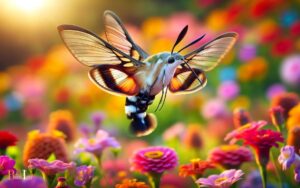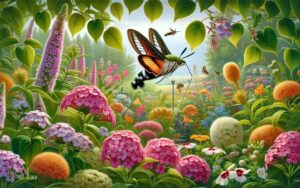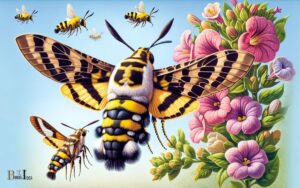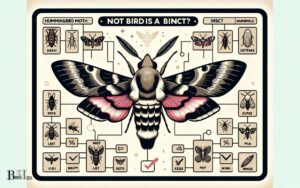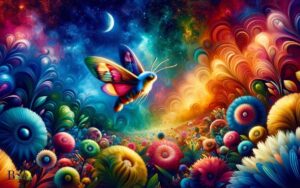Bee Hawk Moth Vs Hummingbird Moth: Discover Differences!
The Bee Hawk Moth and the Hummingbird Moth are often mistaken for their namesake creatures due to their astonishing resemblance.
These fascinating insects are renowned for their remarkable ability to hover in mid-air while sipping nectar from flowers, captivating onlookers with their delicate yet agile flight.
Despite their striking similarities, subtle differences in their appearance and behavior set them apart.
Understanding these remarkable creatures and their unique characteristics offers an intriguing glimpse into the diverse world of moths and their vital role in the ecosystem.

Key Takeaway
Physical Characteristics
The bee hawk moth and the hummingbird moth both possess similar physical characteristics that allow them to be mistaken for their namesake creatures.
These moths have long, slender bodies, and wings that beat rapidly, enabling them to hover near flowers while feeding on nectar.
Their coloring often resembles that of bees or hummingbirds, with patterns of black, white, and yellow, along with a furry body.
Both species also have long proboscises, which they use to reach deep into flowers to access nectar, much like the way a hummingbird drinks.
These physical traits, combined with their swift, agile movements, contribute to the confusion between these moths and their namesake counterparts, making them fascinating subjects for observation in the natural world.
Habitat and Distribution
Both species of moths can be found inhabiting a wide range of environments across North and South America.
The Bee Hawk Moth and the Hummingbird Moth are adaptable creatures that thrive in various habitats, including:
- Forests: Both moths can be found in wooded areas, where they’re often attracted to the rich diversity of plant life.
- Gardens: These moths are commonly spotted in gardens and other cultivated areas, where they’re drawn to the abundance of nectar-producing flowers.
- Grasslands: Both species are known to inhabit open grassy areas, where they can feed on the nectar of wildflowers and other flowering plants.
Their ability to inhabit diverse environments makes them fascinating creatures to observe in the wild.
Flight Behavior
Inhabiting a variety of environments, the Bee Hawk Moth’s flight behavior is characterized by its swift and agile movements as it seeks out nectar-rich flowers for sustenance.
These moths are adept fliers, capable of hovering in front of flowers and swiftly darting from one bloom to another.
Their flight patterns are often erratic, resembling the flight behavior of hummingbirds, which aids in their pollination efforts.
Below is a table highlighting the key flight behavior characteristics of the Bee Hawk Moth:
| Flight Behavior Characteristics | Description |
|---|---|
| Swift Movements | Agile and rapid flight patterns |
| Hovering | Capable of hovering in front of flowers |
| Erratic Flight | Irregular flight patterns resembling hummingbirds |
| Nectar-Seeking Behavior | Flight directed towards nectar-rich flowers for food |
| Pollination Efforts | Active participants in pollination through flight |
This agile flight behavior enables the Bee Hawk Moth to efficiently forage for nectar and contribute to the pollination of various plant species.
Transitioning from flight behavior to feeding habits, the next section will delve into their nectar-seeking behavior and dietary preferences.
Feeding Habits
With a voracious appetite for nectar, Bee Hawk Moths actively seek out and consume nectar from a wide array of flowering plants.
Their feeding habits are fascinating and vital to their survival. Here are a few interesting points about their feeding behavior:
- Bee Hawk Moths have a long proboscis, which allows them to reach deep into flowers to access nectar.
- They’re known to be crepuscular, meaning they’re most active during dawn and dusk when flowers produce the most nectar.
- These moths are important pollinators, as they transfer pollen from one flower to another while feeding.
Understanding the feeding habits of Bee Hawk Moths provides insight into their ecological role and behavior.
This is closely linked to their life cycle and reproduction, which will be further explored in the subsequent section.
Life Cycle and Reproduction
The Bee Hawk Moth’s feeding habits directly influence its life cycle and reproduction. Their foraging behavior plays a crucial role in pollination and the subsequent development of their offspring.
After mating, female Bee Hawk Moths lay their eggs on or near the host plants of their caterpillars.
Once hatched, the caterpillars go through several stages of development, feeding on the host plants until they pupate.
The pupa then transforms into an adult moth, completing the life cycle. During the adult stage, their primary goal is to find nectar-rich flowers for sustenance.
In the process, they facilitate pollination, which supports plant reproduction and ensures the availability of food sources for future generations of Bee Hawk Moths.
This symbiotic relationship between the moth and the plants is essential for their survival and propagation.
This life cycle and reproductive process also demonstrates the Bee Hawk Moth’s crucial role in pollination.
Role in Pollination
Both the Bee Hawk Moth and the Hummingbird Moth play crucial roles in pollination. However, their approaches differ in terms of efficiency and flower preferences.
Understanding the pollination techniques of these two insects can provide valuable insights into their impact on various plant species and ecosystems.
By comparing their pollination efficiency and flower preferences, researchers can gain a better understanding of the ecological significance of these fascinating creatures.
Pollination Efficiency Comparison
Pollination efficiency differs between the Bee Hawk Moth and the Hummingbird Moth due to their unique foraging behaviors.
The Bee Hawk Moth tends to be more efficient in pollination due to its extended proboscis, which allows it to reach nectar in deep flowers that other pollinators can’t access.
The Bee Hawk Moth also has the ability to navigate in low light conditions, further enhancing its pollination efficiency.
On the other hand, the Hummingbird Moth, with its rapid wingbeats and hovering ability, is also an effective pollinator, particularly for shallower flowers.
The Hummingbird Moth’s daytime foraging contributes to pollination in well-lit environments.
Both moths have a high energy expenditure during foraging, resulting in frequent visits to flowers and increased pollen transfer between plants.
Flower Preferences and Impact
In terms of flower preferences and impact on pollination, the Bee Hawk Moth and the Hummingbird Moth exhibit distinct foraging behaviors due to their specialized adaptations.
Bee Hawk Moths are attracted to flowers with long corollas, such as honeysuckles and petunias, which allow them to extend their long proboscis to access nectar.
Their foraging behavior often results in contact with the reproductive parts of the flower, facilitating effective pollination.
On the other hand, Hummingbird Moths prefer tubular flowers like honeysuckles and moth-pollinated flowers due to their long tongues, which enable them to reach nectar in deep floral tubes.
This foraging behavior also leads to effective pollination as they come into contact with the flower’s reproductive structures.
Both moths play a crucial role in pollination by transferring pollen between flowers as they feed, contributing to the reproductive success of various plant species.
What are the main differences between Hummingbird Moths and Bee Hawk Moths?
Hummingbird moths and bee hawk moths differ in several ways. While both are similar in appearance and behavior, the key differences lie in their size, wing shape, and flight pattern. Additionally, hummingbird moth gender differences also exist, with slight variations in color and markings between male and female individuals.
Interactions With Humans
The Bee Hawk Moth and Hummingbird Moth frequently attract attention from humans due to their striking resemblance to hummingbirds and their ability to hover near flowers.
These interactions with humans have sparked various observations and inquiries about their behavior and characteristics.
- Misidentification: Many people mistake these moths for actual hummingbirds due to their similar appearance and behavior.
- Gardening: Gardeners and nature enthusiasts often cultivate plants to attract these moths, contributing to their conservation efforts.
- Photography: These moths are popular subjects for photographers due to their unique traits and behavior, leading to a growing interest in capturing their beauty.
These interactions provide opportunities for education and appreciation of these fascinating insects, fostering a deeper understanding and respect for their role in the ecosystem.
Conclusion
As the bee hawk moth and hummingbird moth continue to flutter through the world, their delicate presence serves as a symbol of the interconnectedness of all living beings.
Their graceful flight and vital role in pollination remind humans of the fragility and beauty of nature.
By understanding and appreciating these extraordinary creatures, humans can strive to protect and preserve the delicate balance of the natural world, ensuring a harmonious coexistence for generations to come.

